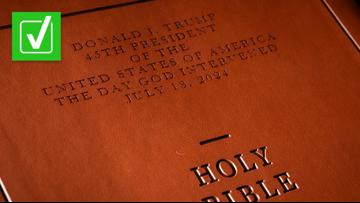Queen Elizabeth II’s face is featured on money across the United Kingdom. Some people on social media are wondering what will happen to the country’s money following her death on Sept. 8 and King Charles III’s ascension to the throne.
One person from the U.K. asked if their money will look different going forward. Another person said they were “baffled” by the idea of reprinting currency to reflect the new king, while others simply asked if their money would have to be reprinted.
THE QUESTION
Will King Charles III’s likeness start appearing on money in the United Kingdom?
THE SOURCES
THE ANSWER
Yes, King Charles III’s likeness will start appearing on money in the United Kingdom, but older money featuring Queen Elizabeth II will remain valid.
WHAT WE FOUND
For the last seven decades, much of the United Kingdom’s money has been printed with Queen Elizabeth II’s face on it. Going forward, that money will now be printed with King Charles III’s face, although the money with Elizabeth’s face will remain valid.
All standard coins issued in the U.K. are minted with the current monarch’s likeness. That means newly minted coins will feature King Charles III’s face going forward.
But only some of the U.K.’s paper money features the image of England’s royalty. That’s because banknotes differ in appearance across the U.K.’s four nations: England, Wales, Scotland and Northern Ireland.
All six banknotes previously circulated by the Bank of England, which is responsible for printing paper money in England and Wales, include Queen Elizabeth II’s portrait on one side. Therefore, future bills will be printed featuring King Charles III’s portrait in place of hers.
The Bank of England has already announced that banknotes featuring Queen Elizabeth II’s image will remain legal tender. It said it will make a further announcement regarding existing paper money after observing the country’s period of mourning.
Three banks in Scotland and three banks in Northern Ireland have authority to issue bills in their respective nations, the Bank of England says. Currently, the Bank of Scotland issues money featuring the face of Sir Walter Scott, a Scottish novelist who lived from the late 1700s to the early 1800s. The banknotes currently issued by the Bank of Ireland (UK) feature an image of Lady Hibernia, a personification of Ireland that uses the Latin name of the island. The other banks in the two nations all print their own banknotes featuring various people and images.
So there’s no reason for banknotes issued by these banks to change now. They didn’t feature Queen Elizabeth II’s likeness, and are unlikely to begin featuring Charles III’s likeness now that he’s king.
And even though the banknotes look different in each nation, they are all still the same British pound with the same value. The Association of Commercial Banknote Issuers, which is the association that oversees the printing of money in Scotland and Northern Ireland, says the bills issued by these six banks are legal currency throughout all of the United Kingdom.
MORE FROM VERIFY: Yes, Charles automatically became King of England after death of Queen Elizabeth II
The process of changing money so it has the current monarch’s likeness is far from new in England, or even in the United Kingdom as a whole.
The Royal Household at Buckingham Palace says that English kings began putting their names on coins as far back as the year 800. King Athelstan, who died in 939, became the first English monarch whose image was actually shown on coins.
“For many people, the king's image on coins was the only likeness of the monarch which they were likely to see in their lifetimes,” Buckingham Palace says.
These coins continued to be used well after the monarch printed on them died. The Royal Mint says coins with Queen Victoria’s likeness from the 1860s were still in use until a 1971 update to the U.K.'s currency system.
Paper money doesn’t have a history of changing after the death of a monarch, but that’s because paper money doesn’t have the same history in the U.K. as coins do.
“Although bank notes began to be issued from the late seventeenth century, they did not come to predominate over coins until the nineteenth century,” Buckingham Palace says. “Only since 1960 has the British Sovereign been featured on English bank notes, giving The Queen a unique distinction above previous monarchs.”
When the country does begin issuing its new coins and bills, it’s likely that King Charles III’s image will face to the left, opposite of the right-facing image of Queen Elizabeth currently on English money. This is because of a tradition dating back to the 1600s, Buckingham Palace says, in which monarchs face the opposite direction of their predecessor on the country’s money.












